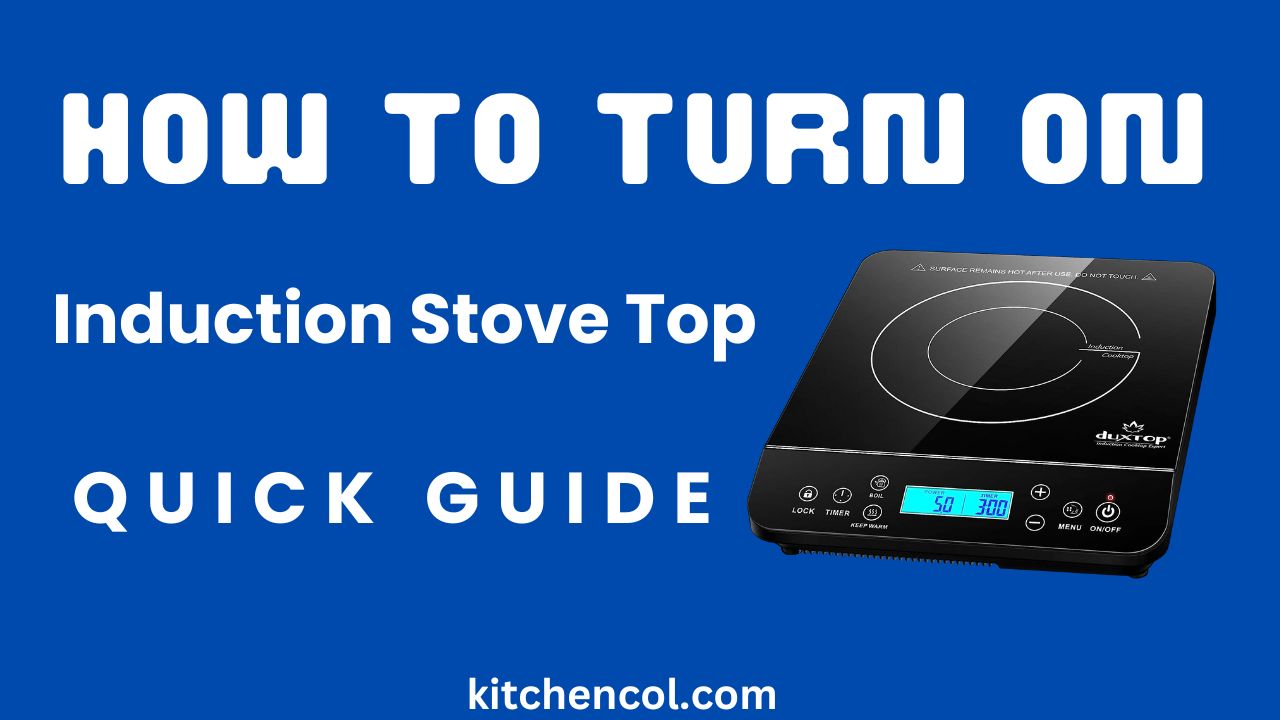Induction stove tops have revolutionized the way we cook, offering remarkable efficiency and precise control over temperature settings. However, for those new to this technology, the process of turning on and using an induction stove top might seem a bit perplexing. In this guide, we’ll unravel the mystery and provide you with a clear and concise step-by-step approach to mastering the art of using an induction stovetop.
From understanding the basics of induction cooking to selecting the right cookware and adjusting temperature settings, we’ll walk you through the process with confidence. Let’s dive in and discover how to harness the power of induction cooking in your own kitchen.
Understanding Induction Cooking Basics
Induction cooking might seem like magic, but it’s rooted in a simple scientific principle: magnetism. Unlike traditional stovetops that rely on gas flames or electric coils, induction stoves use magnetic fields to generate heat directly in the cookware itself. Here’s a brief rundown of the key concepts:
Magnetic Fields and Heat Generation:
Induction stovetops contain a coil of copper wire underneath the glass surface. When you turn on a cooking zone, an electric current flows through the coil, generating a strong magnetic field. This field induces electrical currents in the base of compatible cookware, which, in turn, produces heat. This process heats up the cookware and its contents without directly heating the stovetop surface.
Efficiency and Speed:
Induction cooking is incredibly efficient because it heats up the cookware directly, wasting minimal energy. It’s faster than traditional methods since there’s no need to wait for the stove to warm up – the heat is almost instantaneous. This efficiency also translates into quicker cooking times.

Precise Temperature Control:
The exact temperature control of induction cooking is one of its best qualities. You can adjust the power and temperature settings with great accuracy, allowing you to simmer, sauté, or boil with exactitude.
Safety and Cool Surface:
Since the heat is generated in the cookware, the stovetop surface remains relatively cool. This not only reduces the risk of burns but also makes cleaning up spills easier. Plus, induction stovetops often come with safety features like automatic shut-off when no cookware is detected.
Cookware Compatibility:
To harness the magic of induction cooking, you’ll need cookware made from ferrous materials like cast iron or stainless steel. Cookware made of aluminum, copper, or glass will not function unless it has a magnetic base.
You can check compatibility using a magnet – if it sticks to the bottom, your cookware is induction-ready.
Understanding these basics sets the stage for using an induction stove top effectively and safely. The next steps involve preparing your cookware and getting ready to embark on a culinary adventure with precise control and remarkable efficiency.
Preparing for Induction Cooking
Before you start cooking up a storm on your induction stove top, it’s crucial to get the right tools in place and ensure your cookware is compatible. Here’s what you need to know:
Cookware Compatibility:
Induction stoves require cookware that can generate an electromagnetic current. Look for pots and pans with a magnetic base, such as cast iron or stainless steel. Not all stainless steel is compatible, so check for the induction symbol or do the magnet test. You’re fine to go if the magnet adheres to the bottom.
Flat-Bottomed Cookware:
For optimal heat transfer, make sure your cookware has a flat and smooth bottom. This ensures maximum contact with the induction cooking surface, leading to even heating.
Check Cookware Condition:
Before using your cookware on an induction stove top, ensure that the bottom is clean and free of any debris. Uneven or damaged bottoms can lead to uneven heating and inefficient cooking.
Organize Ingredients:
Gather all the ingredients you’ll need for your dish. Induction cooking heats up quickly, so it’s essential to have everything prepped and ready before you turn on the stove.
Ventilation and Clear Space:
Induction cooking produces minimal ambient heat, but proper ventilation is still important. Ensure there’s enough space around the stove for heat to dissipate and for air circulation.
Safety Gear:
Keep oven mitts and pot holders handy. While the stovetop itself doesn’t get as hot as traditional burners, the cookware can reach high temperatures.
Power Supply:
Make sure your induction stove is properly plugged into a power source and turned on.
By taking these steps, you set the foundation for a smooth and enjoyable induction cooking experience. Compatibility, cookware condition, and organization are key to unlocking the potential of your induction stovetop.
Now that you’re prepared, it’s time to dive into the step-by-step process of turning on and using your induction stove top effectively.
Step-by-Step Guide to Turning On an Induction Stove Top
Now that you’re equipped with compatible cookware and have your ingredients ready, let’s delve into the precise steps of turning on and using your induction stovetop.
Gather Necessary Items:
Before you start, ensure you have your induction stove, compatible cookware, and all the ingredients and utensils you’ll need for your dish.
Plug In and Power On:
Locate a suitable power outlet for your induction stove and plug it in. Most stoves have a power button on their control panel. To turn the stove on, press the power button. The control panel might light up or display indicators to show that it’s powered.
Choosing the Right Cooking Zone:
Look at the layout of the cooking zones on the stovetop. Each zone has its own set of controls. Choose a cooking zone that matches the size of your cookware and the amount of food you’re preparing.
Adjusting Power and Temperature:
Induction stoves offer precise control over power and temperature settings. You might have buttons or touch controls to adjust these settings. Start by selecting the desired power level and temperature for your dish. Higher power settings are used for boiling or searing, while lower settings are suitable for simmering and gentle cooking.
Placing the Cookware:
Center the compatible cookware on the chosen cooking zone. Make sure the bottom of the cookware sits flat against the cooking surface. This ensures efficient heat transfer.
Activating the Cooking Zone:
Depending on your stove, you might need to press a specific button or touch the control panel to activate the cooking zone. Look for indicators such as lights or symbols that show the zone is active.
Setting Cooking Parameters:
Once the zone is active, you can fine-tune the power and temperature settings if needed. Many stoves allow you to adjust these settings even after cooking has started.
Starting the Cooking Process:
With your cookware in place and the settings adjusted, start adding your ingredients to the cookware. The heat will begin transferring to the cookware almost instantly. Stir and manage the cooking process as required.
Monitoring and Adjusting:
Throughout the cooking process, stay attentive. Induction stoves respond quickly to changes in settings, so you can increase or decrease the power as needed. Keep an eye on your dish’s progress and make adjustments for the perfect outcome.
By following these steps, you’ll be able to confidently turn on and use your induction stove top to create a wide range of dishes with precise control over heat and temperature. As you gain experience, you’ll discover the joy of cooking with an induction stove top’s efficiency and responsiveness.
Safety Precautions
While induction stoves offer convenience and efficiency, it’s important to prioritize safety in your culinary endeavors. Here are essential safety precautions to keep in mind:
- Cookware Placement: Ensure your cookware is centered and stable in the cooking zone. Unstable cookware can lead to accidents.
- No Cookware, No Heat: Induction stoves won’t generate heat without compatible cookware. If you remove the cookware, the heat stops instantly.
- Hot Surfaces: While the stovetop itself remains cooler than traditional burners, the cookware becomes very hot. Always use oven mitts or pot holders to handle hot pots and pans.
- Spill Awareness: Wipe up spills promptly to prevent them from burning onto the cookware or stovetop surface.
- Children and Pets: Keep curious hands and paws away from the cooking area. Many stoves have safety locks to prevent accidental adjustments.
- Ventilation: Ensure proper ventilation to prevent overheating in the kitchen. Avoid blocking air vents or fans.
- Unplug After Use: When you’re finished cooking, unplug the induction stove from the power source to prevent unintentional activation.
- Follow Manufacturer’s Guidelines: Always refer to the manufacturer’s instructions and guidelines for your specific induction stove model.
By adhering to these safety precautions, you can fully enjoy the benefits of induction cooking while ensuring the well-being of yourself, your family, and your home.
Cleaning and Maintenance
Proper cleaning and maintenance of your induction stovetop are essential for its longevity and continued performance. Here’s a quick guide to help you keep your appliance in top condition:
- Cool Down: Allow the stovetop to cool down before cleaning to avoid burns.
- Wipe After Each Use: Wipe the surface with a damp cloth or sponge after each use to prevent food residues from hardening.
- Use Suitable Cleaners: Use non-abrasive cleaners or mild soapy water to clean the surface. Avoid harsh chemicals that could damage the glass or controls.
- Cookware Marks: Clean any marks left by cookware on the glass surface. Use specialized cooktop cleaning creams for stubborn stains.
- Burned-On Residues: For tougher stains, use a scraper designed for glass cooktops. Gently scrape off residues and then clean with a recommended cleaner.
- Ventilation: Keep air vents and fans clean and clear to maintain proper airflow and prevent overheating.
- Regular Inspection: Periodically inspect control buttons and indicators for any wear or malfunction. Consult the user manual for instructions.
- Avoid Excess Water: Prevent liquids from seeping into the control panel or the cooking zone connectors.
By dedicating a little time to regular cleaning and maintenance, you’ll ensure that your induction stove top continues to shine and perform at its best, making cooking a delight every time you step into the kitchen.
Also Read: How to Use Electric Stove Touch Screen-Step BY Step Guide
Final Words
Mastering the art of using an induction stove top opens up a world of efficient and precise cooking possibilities. With its rapid heat generation, precise temperature control, and safety features, induction cooking offers both novice and experienced chefs a valuable tool in the kitchen.
By understanding the science behind induction cooking, preparing suitable cookware, and following our step-by-step guide, you can confidently create a variety of dishes with ease.
Remember, safety is paramount when working with any cooking appliance, and induction stoves are no exception. Following the provided safety precautions ensures a secure and enjoyable cooking experience. Additionally, regular cleaning and maintenance uphold the stove’s performance and aesthetic.
Induction cooking harmonizes technology with culinary artistry, providing the means to cook efficiently and with precision. Armed with this knowledge, you’re ready to harness the power of induction cooking to elevate your culinary adventures and create delicious meals that will impress family and friends alike.

My name is Manan Bukhari and I am an expert in reviewing kitchen products for years. I have a passion for testing multiple gadgets especially related to home & kitchen. I love to spend my free time in resolving issues if I face some in any of my daily use things. I have fixed multiple gadgets of my home on my own without any assistance and that thing gave me confidence to make a blog on troubleshooting of items that are for daily use to assist you folks. Even my wife praises me for having such talent. I always explore new machines on my own because this thing fascinates me.



